|
C-Slow
Retiming
It
must be stated, that C-Slow Retiming (CSR) is
already very well known. Nevertheless, I do think, that this technique
has much more potential than it is currently used. This CloudX
initiative is set up to change this and to place real-world examples on
the table of anybody who asks for it.
Theory
of CSR
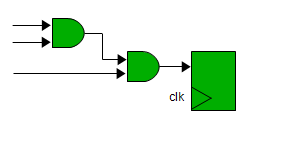 |
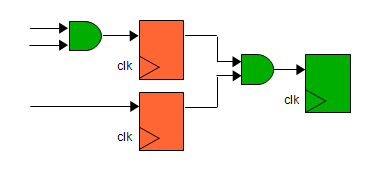 |
| Figure
1: Solving an equation in one cycle. |
Figure
2: Solving the same equation in 2
cycles.
|
Figure 1 shows
a simplified example of a digital logic. The combinatorial logic is
solved within one cycle. In
Figure 2 registers are inserted in the digital logic. The logic result
is the same, but it takes now 2 cycles so solve the same combinatorial
logic. The point is, that in
the second
cycle, you can already start a completely independent calculation of a
new result. The
simplified example also shows, that in theory you can run
the clock at twice the speed, so that the overall time to solve one
single equation does not change. In other words, by adding registers,
you have the chance to solve the same equation twice as often.
Now let's use
this technique on a complete design.
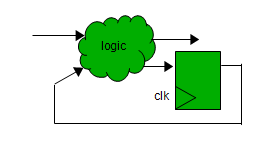
|
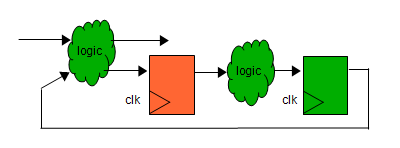
|
| Figure 3: Simplification of single clock
design. |
Figure
4: Single clock design after register insertion.
|
Any
(single clock) design can be defined as a set of
inputs, outputs, a graph of logic elements and registers (Figure 3).
CSR now executes this register insertion on a more complex design
automatically, as can be seen in Figure 4. Now is takes 2 cycles to
achieve the same behavior as the original design, but you have a
second, totally independent design which uses the combinatorial logic
in a time sliced fashion.
It
is totally irrelevant, if the original design is already pipelined
(as in a CPU for instance). If you follow the rule to insert the same
number of registers in any of the original logic paths, you multiply
the functionality of the design/core. If the registers are timing
driven
placed, the performance of a single core remains almost the same. More
register levels can be inserted and the functionality multiplies
accordingly. The automatic
register
insertion on RTL simplifies the SoC-implementation,
necessary code optimizations (e.g. memories) by hand and the
verification process.
CSR and
area reduction
Figure 5: A6
processor (source: techinsights.com).
Figure 6:
A6X
processor (source: techinsights.com).
The
most obvious advantage of using CSR is area reduction. CSR can be
applied to combinatorial logic of identical core instantiations. As in
the case of the A6 processor (Figure 5), CSR could potentially be
executed on the
two ARM cores (10% area reduction of the red area) as well as on the
three GPU cores (32% area reduction of
the yellow area). This would already result in a 6.7% area reduction of
the complete die.
These numbers might not be overwhelming, but since more and more
multicores are implemented - "the processor is the new transistor" -
the area reduction might go up to 10%, 20% or even more. In the FPGA
world, the area utilization is even greater, since the registers
"already exist".
An example for the
increasing importance of using CSR is the A6X processor
(Figure 6). It is using a
larger GPU
and now 4 instead of 3. Since CSR is more efficient of larger designs
(GPUs) and the number of
identical designs increased, the potential area reduction for the A6X
is now 14%.
CSR on
RTL
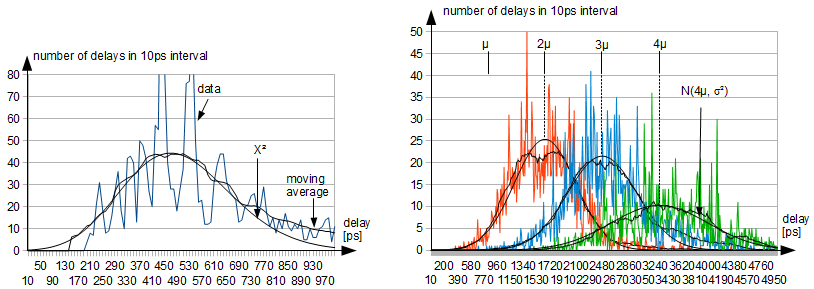
Figure 7: X²
distribution of single net delay.
Figure 8: Gaussian for consecutive nets.
CSR on RTL has a lot
of advantages, and it is questionable if it is doable
on netlist at all. I use simple empirical observations, such as that
the
net delay of an FPGA net follows a X² distribution (Figure 7),
which
ultimately leads with k > 70 to a Gaussian for consecutive
delays
(Figure 8). This observation allows the insertion of registers on RTL
quite efficiently [1].
Examples
CSR and TMR
CSR
can also be used to generate a time multiplexed triple modular
redundant system [2].
References
[1]
T.Strauch,
"Timing Driven C-Slow Retiming on RTL for MultiCores on FPGAs",
ParaFPGA2013, 10-13 September 2013, Munich, Germany, pages 1-6, also at
Cornell University
Library, 14th July
2018, https://arxiv.org/abs/1807.05446,
or here.
[2]
T.Strauch, "Using C-Slow Retiming in Safety Critical and Low Power
Applications", First International Workshop on FPGAs in Aerospace
Applications", FASA 2014, 5 September 2014, Munich, Germany, with an
almost similar version publicly available here: T.Strauch,
"Running Identical Threads in C-Slow Retiming based Designs for
Functional Failure Detection", Cornell University Library, 4th February
2015, https://arxiv.org/abs/1502.01237,
or here.
Articles
-
T.
Strauch, 2010, Hyper pipelining of
multicores and SoC interconnects, EETimes, 11/2/2010, link,
pdf
|